Has the world of Limoges china recently grabbed your interest? Perhaps you’re looking to join the community of Limoges porcelain enthusiasts as a collector? Whatever the case is, you’ll be glad to know that you’re in the right place because we’ve got just what you need!
The unparalleled beauty of Limoge china is sufficient to persuade antique collectors to obtain the best and rarest kinds of Limoges china currently on the market. Although being an integral part of the Limoges china isn’t as simple and effortless as you might’ve expected, there’s nothing for you to worry about because we’ve come to your aid!
If you’re new to the world of Limoges wares, then there’s a lot that you need to understand before starting out your Limoges porcelain collection. It’s essential for you to fully comprehend the history of Limoges china, its various manufacturers, identification, and value guide. You also need to know how you can effectively check the authenticity of Limoges pieces to ensure that you don’t spend your money on cheap remakes.
Fortunately for you, we’ve compiled everything you need to know about Limoges china in this guide, so without further ado, let’s get straight into the topic!
Table of Contents
What Is Limoges Porcelain?
Before we dive straight into the identification of Limoges china, you need to make ensure that you fully understand what Limoges porcelain is and where it originates from. For beginners, Limoges porcelain is basically hard-paste porcelain manufactured in factories around the city of Limoges, France. Beginner collectors of Limoges china confuse the word Limoges as referring to a certain company or manufacturer responsible for producing particular porcelain wares; however, this comprises numerous Limoges factories that deal with the manufacturing of the finest hard paste porcelain.
Some of the oldest Limoges china pieces date as early as the late 18th century, during which time, some of the rarest and most precious Limoges porcelain pieces in today’s market were produced. This incredible piece of pottery continues to impress collectors and traders primarily because of its huge variety of designs and exceptional versatility in pairings. Even today, Limoges china continues to be one of the most popular trends among collectors and traders.
Brief History Of Limoges China
Being knowledgeable in the field of Limoges china will certainly help you while building your own collection. Knowledge about Limoges porcelain means being aware of its history, including where the concept originated from and how it evolved and gained popularity over the years.
The production of porcelain in Limoges, France, dates back to the 1700s with the discovery of kaolin clay near the Limoges region. Porcelain production had started long ago in other regions, such as Germany; however, this discovery proved to be vital in promoting the concept of porcelain made from kaolin all across the globe. Manufacturers in France soon became involved in the production of the best quality Limoges china at the time, which resulted in immense profits following the renowned French revolution.
In 1781, King Louis XIV arrived in France and bought a local porcelain factory in Limoges. This was done primarily to produce porcelain for his court; however, it greatly promoted porcelain production in Limoges and soon, various other factories joined in to benefit from the porcelain production business. The region began to attract international clients who had found interest in the kinds of porcelain produced in Limoges.
The 1925 Paris International Exhibition Of Decorative Art featured Limoges china, which significantly boost the popularity of these pieces throughout the globe. Following this, various factories in Limoges became known to be some of the greats with acceptance in the local as well as international markets.
Even today, Limoges continues to be one of the most popular and vibrant regions for the production of porcelain. The area has received international recognition for being one of the main ceramic production regions with a sound reputation in the industry. Over the years, Limoges china has further advanced with the invention of new and innovative designs discovered from collaborations with qualified designers, such as Franz Bischoff, a notable artist from America.
Limoges porcelain is popular because of its impressive designs and patterns and the exceptional quality of dinnerware that fall into the category of Limoges china. A distinct feature of porcelain produced in Limoges, France, is that all designs and patterns are fairly unique. It is nearly impossible to come across multiple pieces having the same pattern or design. This further adds to the rarity and value of most porcelain pieces from France.
If you’re willing to learn more, be sure to check out this detailed guide on the history of Limoges porcelain.
Identification Using Limoges China Marks
The next thing that you need to learn is how to identify a piece of Limoges porcelain. Although beginners with little to no knowledge of Limoges china are likely to struggle with this step, there are certain tips that make this much simpler and effortless for you. You can make this identification process much more convenient for yourself by having an expert collector or trader look at the piece.
Alternatively, if you intend to give it a shot yourself, the first thing that you must do is look for marks beneath the porcelain piece. Various Limoges trinket boxes, vases, and dinnerware are likely to have a factory mark that hints towards the original manufacturer of the piece. The marks beneath your porcelain will help you make sure that you’re dealing with an authentic piece as well as allow you to understand the origins of the piece.
Here are the different kinds of Limoges china marks that you need to look out for.
French Government Mark
You may come across various porcelain pieces marked with the official French government mark. This simply implies that the porcelain piece isn’t associated with any manufacturer in particular and simply identifies the piece as a Limoges china. Generally, this mark is a round circle enclosed with the words “Limoges Goût de Ville”. In other scenarios, there might not be any official mark but you will see the letter “L”, which stands for Limoges.
Factory Marks
Various Limoges china marks are believed to be the official factory marks that hint towards a certain factory or manufacturer responsible for producing and distributing the product. Analyzing and understanding this mark is a major part of the identification of a Limoges china piece since it allows you to track down the exact origins of the piece. This is essential in drawing an accurate estimate of the value and worth of the piece in the market.
Name Of The Artist
In various scenarios, you might notice the name of the artist that had hand painted on the Limoges piece of porcelain imprinted somewhere on the product. Additionally, such pieces are also stamped to indicate that they have been hand-painted. Three different types of notations are used to relay to the collector how a particular Limoges piece was designed.
- Paint main – The piece was decorated primarily by hand
- Decor main – Partial painting was done by hand
- Rehausse main – Only highlights were done by hand
Popular Makers Of Limoges Porcelain
Ever since the idea of Limoges china had been popularised in the early 19th century, numerous factories and manufacturers have joined in to benefit from the business. Many of these factories became known as some of the most popular and renowned manufacturers of Limoges china in history. Every factory of this era brought something new to the world of porcelain production with intriguing and appealing art styles and patterns. With unique and effective decoration techniques, some of the most precious pieces were produced. Many of these pieces are being sold in today’s market for various thousands of dollars.
Being aware of the factory marks generally used by these various manufacturers of Limoges porcelain will certainly help you identify pieces more effectively and without much struggle. Here are some of the most popular manufacturers of Limoges porcelain:
King Louis XIV’s Factory
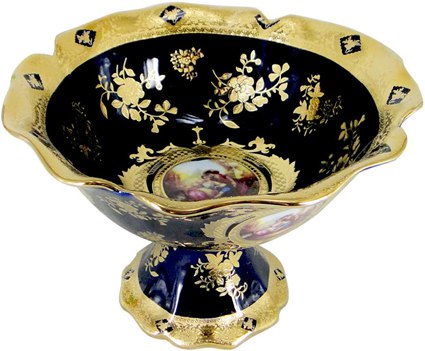
This porcelain factory was initially a manufactory under the patronage of Comte d’Artois, who was the brother of King Louis XIV. The factory was purchased by the king in 1784 and eventually became the first ever manufacturer of Limoges china. The Limoges marks on their products consist of a crown or a royal monogram. The crown is typically used to identify products as being manufactured in France.
Allund Factory
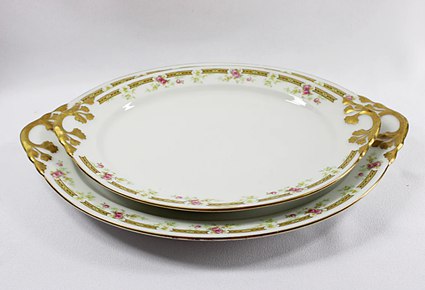
Allund factory was a very well-known manufacturer of Limoges china that was founded back in 1797. The company continued to function under this name until 1868 and produced some of the rarest and most precious pieces of Limoges china that we know today. The factory mark “AE” was generally found on products manufactured by them.
Theodore Haviland Limoges France
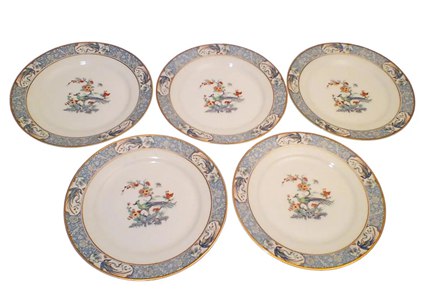
Theodore Haviland Limoges France, originally known as Haviland & Co was founded by David Haviland in 1868 with the purchase of the Allund factory. The Haviland family name was carried on by his sons, Theodore Haviland and Charles Haviland, who eventually dissolved their partnership in 1891 and Theodore Haviland took complete control over the business.
Over the years, the company has produced some of the most prized possessions in the Limoges china market and continues to manufacture new and improved dinnerware today. The Limoges marks commonly found on their products consisted of CHF, CHF/GDM, or CH Field Haviland until 1898. Afterward, their usual markings were Porcelaine, Haviland & Co. Limoges, GDA, H&CO/Depose, H&CO/L, or Theodore Haviland, Limoges, France
Elite Works
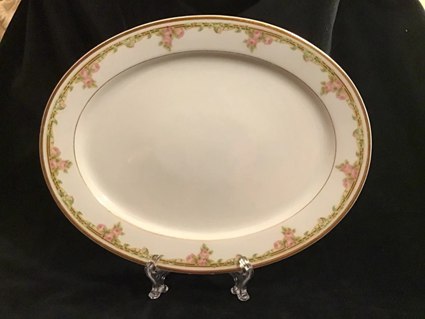
Elite Works, which joined the Limoges production business in 1892, soon left a mark on the industry with significant contributions to the world of Limoges china. Their products were either marked with “Elite France” or “Elite Works France”. The Elite France logo was initially in black; however, they changed this color to red from 1900 to 1914 and became green afterward. The color of marks on products manufactured by Elite Works can also be used to provide an accurate estimate of the age of the piece.
Other Makers
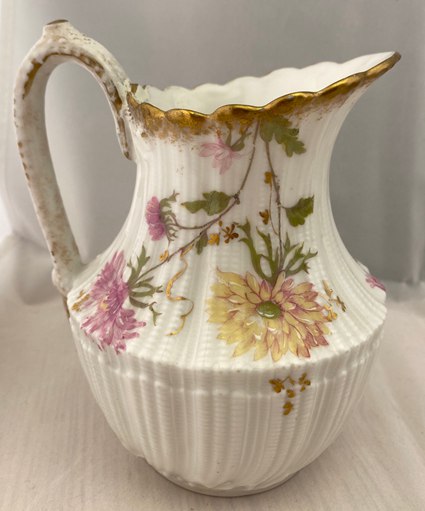
There were various small makers of Limoges porcelain that weren’t as renowned as other factories and manufacturers in the market. Many of these small-scale factories had the marks “M. Redon” (1853), “A. Lanternier” (1885), and “C. Ahrenfeldt” or “France C.A. Depose” (1886).
Products from Latrille Freres had a mark that consisted of a circle enclosed by the words “LIMOGES” and “France”. Martin Freres and Brothers used the marker of a bird with a ribbon and the words “France” imprinted on it. R. Laporte’s mark comprised of “RL/L” with the symbol of a butterfly. Coronet produced porcelain marked with a crown and the words “Coronet” in either blue or green.
Popular Limoges China Patterns
By now, you’re fully aware of how you can identify the exact origins of a particular Limoges china on the basis of its manufacturer’s mark. You also need to understand that in certain scenarios, the mark might not be imprinted on the piece or you might not be able to identify the manufacturer that is hinted through the mark. In this case, you may try to identify the porcelain primarily on the basis of its designs and patterns.
Limoges china is popularly known for its unique designs and patterns, making it possible for collectors to acknowledge the history of a particular piece solely on the basis of its pattern. Here are the types of patterns adopted by some popular manufacturers of Limoges porcelain:
Haviland Porcelain Patterns
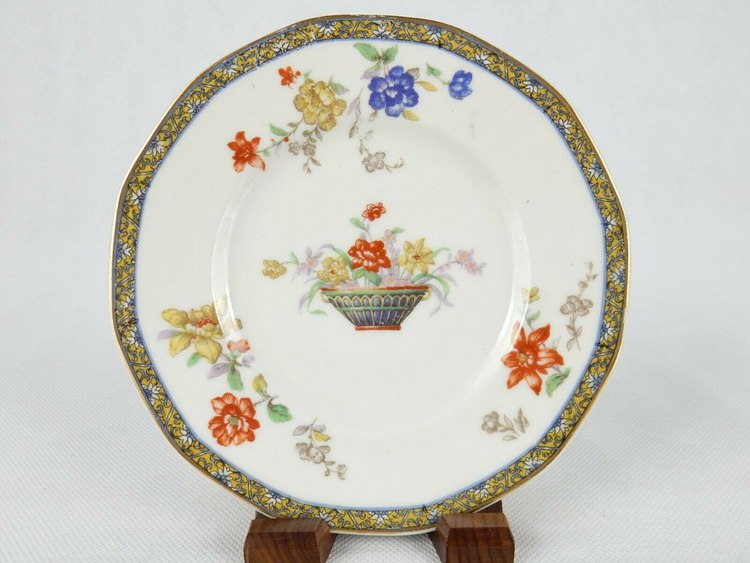
If you’re entering the word of Limoges china as a collector, then you are likely to come across hundreds of porcelain designs and patterns implemented by Haviland. Although Haviland patterns aren’t named, they are easily distinguishable because of their uniqueness and immense appeal. Many Haviland patterns can be viewed from collector books that you’ll be able to find from collectors and traders. They primarily featured floral designs with gold trim; however, their variation in color schemes made each pattern appear distinct and impressive in its own way.
A. Lanternier China Patterns
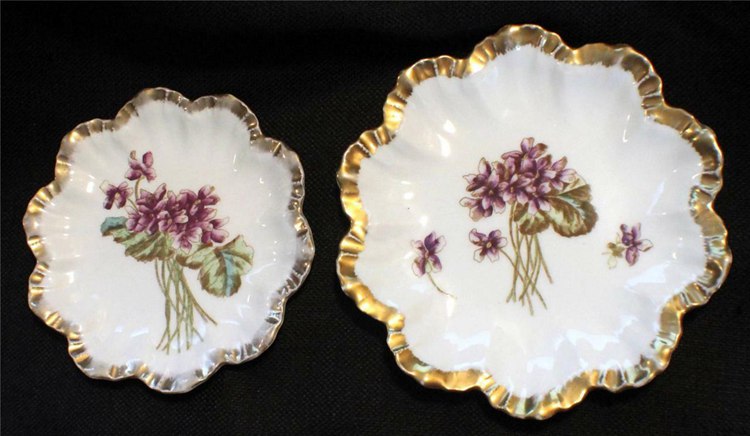
Lanternier typically produced dinnerware with floral and scroll-like designs on a white background that brought a different appeal to the product. They also released various war motifs, a major example of which is the “La Grande Guerre Dessins de Job” series. Mostly, their patterns simply circled the edges of the plates; however, they’ve also released patterns and designs covering the entire plate.
Coronet Limoges China Patterns
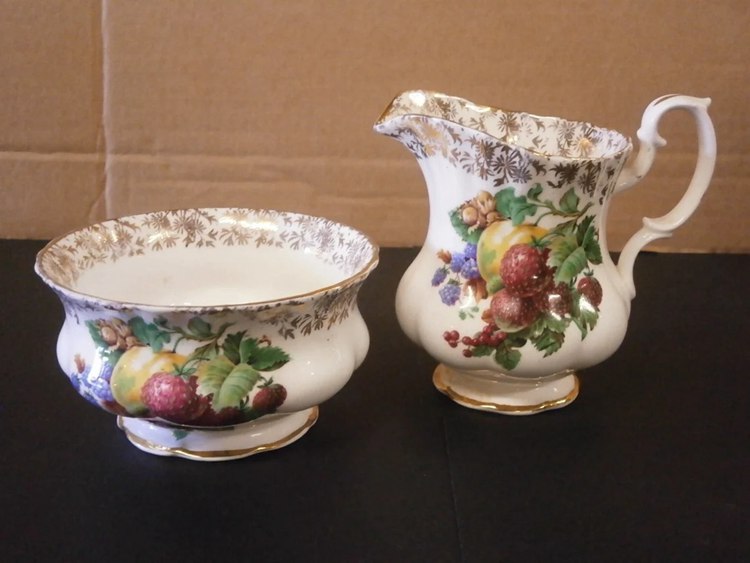
Coronet Limoges patterns were generally associated with nature with certain designs featuring birds, fish, and other animals. In addition to the wildlife, they also used different types of flowers, especially roses, to add to the ultimate appeal of their products. They frequently used a gold trim on the rims along with scalloped edges that reinforced their attractive patterns.
How To Spot Fake Limoges Porcelain?
Unfortunately, the modern Limoges china market is cluttered with thousands of fakes and remakes that are complete scams with no authenticity. Dealers might try to present such pieces as originals; however, they have no historic or monetary value, making them completely worthless to collectors.
Although it can be quite difficult for beginners with little knowledge to distinguish a fake from an original; however, there are certain steps that you can take to make this process more convenient for you.
- The first thing that you need to do is grab a magnifying glass and carefully examine the body of the porcelain. You need to have an eye for detail to closely inspect the decorations on the piece, which might seem unappealing and underwhelming if the piece is fake.
- The weight of the piece can help you determine its authenticity. Fakes are naturally heavier than originals because different materials are used to manufacture porcelain in the modern era. If the piece seems heavier than expected, then there is a fair chance that it is a remake.
- Next, you need to carefully analyze the maker’s mark on the back of the china. Perform your research to identify the company that that is hinted toward by the mark. Although fake marks might seem quite similar to originals, there are certain discrepancies that can help you distinguish between them. Fake marks generally have the word “Limoges” spelled incorrectly, allowing viewers to deduce such pieces as fakes at first glance.
- If the piece has gold trim, then you need to pay close attention to how new or fresh it appears. If it seems too shiny or has other features that help to identify the piece as brand new, then it’s safe to assume that the piece is a fake.
The next time you come across a Limoges china in the market, be sure to check for its authenticity with the help of the steps listed above to avoid wasting your money on worthless remakes with no actual importance. For further validation, you can choose to get the piece viewed by an expert with a fair amount of knowledge regarding Limoges Porcelain. Experts and experienced collectors are able to distinguish between fakes and originals with just a single glance.
Value Guide For Antique Limoges Porcelain
Collectors and traders need to have a general idea of the value of porcelain pieces from Limoges in today’s market. Honestly, there are numerous factors that are responsible for determining the accurate price of a piece of porcelain according to today’s standards. If the piece is known to have wonderful decorations and exceptional detailings that distinguish it from other competitors, then it is likely to be valued high in the market.
Moreover, if the porcelain is painted and decorated by a renowned artist or designer with a sound reputation in the world of porcelain production, then this could certainly cause the value of the piece to rise substantially.
Porcelain pieces from Limoges generally fall into the range of $30 to $60; however, certain pieces might go as high as thousands of dollars depending primarily on their rarity, artist, manufacturer, and quality. Here are some examples of pieces that fall into this price range:
- This impressive Charles Martin & Duche Limoges Pink Roses Floral Plate, Antique France 8 3/4″ sold for $40.00
- This antique Limoges Porcelain Gold Gilt Plate~c1880~French~Pink Rose~19thc~Scalloped~China sold for $45.00
- This beautiful Theodore Haviland Pair of Limoges Teacups Schleiger 597 Style sold for $55.00
Final Thoughts
Various antique collectors of the modern era take pride in the collection of Limoges porcelain products primarily because of the remarkable artistry and beauty that these pieces are known to have. While porcelain collection is itself a trend among collectors, beginners can try and refine their interest further by seeking products manufactured in the Limoges region. These are arguably the finest quality and best kinds of porcelain worldwide with thousands of enthusiasts all across the globe.
With that said, if you have any questions regarding the topic, be sure to let us know in the comment section below and we’ll get right back to you!

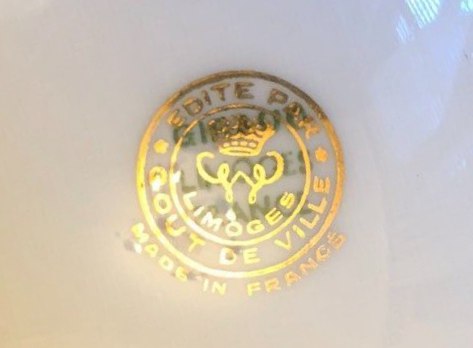




![Where To Sell Antique Furniture In 2022 [Ultimate Guide]](https://www.jacquelinestallone.com/wp-content/uploads/2022/09/Etsy-Your-Place-To-Buy-And-Sell-All-Things-Handmade-600x450.jpg)


